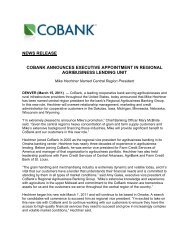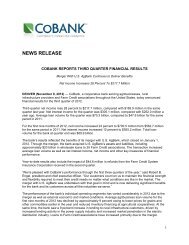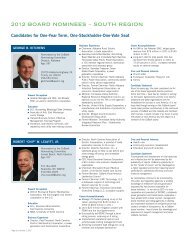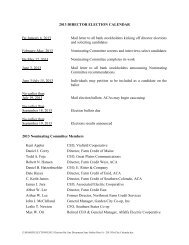The total notional amount of our derivatives portfoliodecreased by $1.6 billion in 2010. The decrease was largelydue to lower levels of liquidity management derivatives, as weissued larger amounts of floating-rate term debt to meet ourliquidity objectives instead of using derivatives that convertfixed-rate term debt to floating-rate. This was partially offsetby increased options risk management hedging to manage ourrisk to rising interest rates and higher levels of equitypositioning hedging resulting from the Bank’s continuedgrowth in capital.Liquidity ManagementA majority of our interest rate swaps are executed toimprove liquidity, primarily by converting specific longertermfixed-rate bonds and notes into floating-rate debt indexedto LIBOR or similar short-term rates. The fixed rate receivedon the swap largely offsets the fixed rate paid on theassociated debt leaving a net floating rate payment on theswap. This allows us to issue longer-term debt and still matchfund the predominantly short-term repricing nature of ourinterest-sensitive asset portfolio. Liquidity risk management isdiscussed further beginning on page 52.Equity PositioningWe also use interest rate swaps to manage interest raterisk as it relates to investment of our equity. If the cash flowsof loans and investments on the balance sheet do not create thetargeted maturity for the investment of our equity, we enterinto receive-fixed interest rate swaps to produce the desiredequity investment maturity profile.Options Risk ManagementIn the course of managing risk in the investment portfolio,we periodically hedge cap risk embedded within our floatingrateinvestment securities that do not meet our current riskmanagement objectives. We enter into offsetting derivativetransactions to hedge this risk.Customer TransactionsDerivatives are offered to customers as a service to enablethem to modify or reduce their interest rate and foreignexchange risk by transferring such risk to us. We substantiallyoffset this risk transference by concurrently entering intooffsetting agreements with counterparties.Foreign Currency Risk ManagementWe enter into foreign exchange spot and forwardcontracts to manage currency risk on our relatively nominalamount of loans denominated in foreign currencies. Typically,foreign currency contracts are purchased to fund the principalcash flows of the loan and simultaneously sold to lock in theprincipal and interest cash flows upon the repricing ormaturity date of the loan.Counterparty ExposureThe use of derivative instruments exposes us tocounterparty credit risk. Credit risk associated with derivativesis measured based on the replacement cost that would beincurred should the counterparties with contracts in a net gainposition with respect to <strong>CoBank</strong> fail to perform. We minimizethis risk by diversifying our derivative positions amongvarious counterparties, using master netting agreements,requiring collateral with daily posting and zero thresholds tosupport credit exposures with active counterparties, evaluatingthe creditworthiness of each counterparty, establishingindividual credit exposure limits and dealing exclusively withcounterparties that have an investment grade or better creditrating from a major credit rating agency. In addition, wemonitor counterparty credit default swap spreads and othermarket-related information which may indicate reducedcreditworthiness of a counterparty.We measure counterparty credit risk daily based on thecurrent fair values of our derivative positions. Personnel whoare independent of the derivative portfolio managementmonitor the derivative exposures against approved limits.Exceptions to approved limits are reported to the CLC, alongwith a plan detailing actions to address limit overages.Changes to the counterparty limits must be approved by theCLC.We also perform stress tests on the derivative portfoliousing asset/liability models to analyze the potential effects ofmarket rate changes on fair value, including extreme ratechanges. The forward interest rate curves used to project thefuture expected cash flows for the derivative positions aremodeled under potential scenarios which increase anddecrease interest rates within a 99 percent confidence interval.These extreme rate scenarios are then used to further evaluatepotential counterparty credit risk and to establish placementlimits.Notwithstanding our credit evaluation process and themaintenance of collateral agreements with our derivativecounterparties, the failure of a counterparty to perform on itsobligations could negatively impact our earnings.Furthermore, although our credit evaluations consider thepossibility of default by a counterparty, our ultimate exposureto default by a counterparty could be greater than expected.The following table details the notional amount of ourderivatives and related exposure to dealer counterpartiesclassified by their Standard & Poor’s credit rating as ofDecember 31, 2011.Derivative Counterparty Exposure ($ in Millions)AAA AA A Below AExposure to Counterpartiesin Net Gain Position$ - $ 327 $ 542 $ -Collateral Held - 321 530 -Exposure, Net of Collateral $ - $ 6 $ 12 $ -Total Notional Amount $ - $ 8,784 $ 13,683 $ -Total Number ofCounterparties- 6 11 -<strong>CoBank</strong> 2011 <strong>Annual</strong> <strong>Report</strong>51
The notional amount of our derivatives and relatedexposure to customer counterparties were $3.1 billion and$152.5 million, respectively, at December 31, 2011 comparedto $2.2 billion and $77.4 million, respectively, atDecember 31, 2010. Customer derivative agreements aresecured through our loan agreements.Liquidity Risk ManagementWe must continually raise funds to provide credit andrelated services to customers, repay maturing debt obligationsand meet other obligations.Our primary source of liquidity is the ability to issueFederal Farm Credit Banks Consolidated Systemwide bonds,medium term notes and discount notes (collectively referred toas Systemwide Debt Securities), as well as the use of availablecash. Additionally, if necessary, we could convert high creditquality and liquid investments to cash. We and other Systembanks maintain a liquidity framework wherein U.S. Treasuryand other U.S. government-guaranteed securities aremaintained. Pursuant to these requirements, the first 15 daysof maturing debt coverage must be maintained with cash, cashequivalents and/or U.S. Treasury securities with maturities ofless than three years. The next 30 days of debt coverage isgenerated from investment securities with an explicitguarantee from the U.S. government, and highly-ratedcommercial paper that matures in 45 days or less. We were incompliance with the 15 and 45 day liquidity requirementsthroughout 2011.As a result of the System’s credit quality and standing inthe capital markets as a GSE, we have traditionally maintainedready access to debt-funding, notwithstanding volatility in thecredit markets and the 2011 downgrades of the long-term U.S.sovereign credit rating and the System’s long-term debt rating,as discussed in “Other Risk Factors” beginning on page 54.Our liquidity management objectives are to meetmaturing debt obligations, provide a reliable source of fundingto borrowers, provide additional liquidity if market conditionsdeteriorate for a period of time and fund operations on a costeffectivebasis. Approximately 67 percent of our interestearningassets mature or reprice in one year or less with48 percent maturing or repricing in one month or less. Matchfundingthese assets from a maturity perspective would createan unacceptable concentration of short-term liabilities.Instead, we manage this risk by issuing longer-term debt andswapping this debt from a fixed to floating rate usingderivative transactions, as previously described. By so doing,we reduce the need to fund maturing liabilities on any givenbusiness day to a more manageable level. While we believethat sufficient resources are available to meet liquiditymanagement objectives through our debt maturity structure,holdings of liquid assets and access to the capital markets viathe Funding Corporation, the volatility of our loan volumecauses our liquidity to vary significantly from day to day.The amounts and maturities of our debt obligations are setforth in the table below.Debt Maturities as of December 31, 2011 ($ in Millions)BookPar1Day (1) $ 2,312$ 2,3122-7 Days 84 848-30 Days 1,901 1,90131-90 Days 3,199 3,19991-180 Days 4,423 4,403181-365 Days 10,102 10,0691-5 Years 24,689 24,104Over 5 Years 10,394 10,144Total $ 57,104$ 56,216(1) Includes $792.3 million of cash collateral payable to derivative counterparties thatdoes not have a stated maturity date.See Notes 5 and 15 to the accompanying consolidatedfinancial statements for information regarding interest ratesand maturities of Systemwide Debt Securities, andcontingencies.Due to the often volatile funding needs of certaincustomer sectors, in particular Agribusiness customer sectorsimpacted by seasonal borrowing requirements and changingcommodity prices, we provide a significant amount ofrevolving loan commitments. At December 31, 2011,commitments to extend credit and commercial letters of creditwere $27.3 billion and $383.3 million, respectively. Inaddition, we provide standby letters of credit, which guaranteepayment or performance of an obligation. As of December 31,2011, the maximum potential amount of future payments thatwe may be required to make under standby letters of creditwas $1.3 billion. Since many of these commitments mayexpire without being drawn, the total commitments do notnecessarily represent future cash requirements. Our exposureto many of these commitments is mitigated by borrowing baserequirements contained in loan agreements. See Note 10 to theaccompanying consolidated financial statements for a fulldiscussion of financial instruments with off-balance sheet risk.We monitor our liquidity position by assuming no abilityto issue debt and calculating the number of days into the futurewe could meet maturing debt obligations by using availablecash and liquidating investments. FCA regulation requires usto maintain a minimum of 90 days of liquidity (cash andreadily marketable investments generally discounted by 5 to10 percent of market value) on a continuous basis. Ourmanagement target is 180 days of liquidity. During 2011, weaveraged 199 days of liquidity compared to an average of240 days in 2010. As of December 31, 2011, we had 234 daysof liquidity, compared to 198 days at December 31, 2010.<strong>CoBank</strong> 2011 <strong>Annual</strong> <strong>Report</strong>52
- Page 4 and 5:
Everett DobrinskiChairmanRobert B.
- Page 6 and 7: “ We firmly believe the combined
- Page 8 and 9: associations are partnering with Co
- Page 11 and 12: 2012 BOARD OF DIRECTORSOccupation:F
- Page 13 and 14: “WE ARE COMMITTEDTO GOOD GOVERNAN
- Page 15 and 16: U.S. AgBank CEO Darryl Rhodes (fron
- Page 17 and 18: KansasNew MexicoUtahFC of Ness City
- Page 19 and 20: CorporateCitizenshipAT COBANKSuppor
- Page 21 and 22: StrategicRelationshipsFarm Credit o
- Page 23 and 24: RegionalAgribusinessBANKING GROUPCe
- Page 25 and 26: CorporateAgribusinessBANKING GROUPK
- Page 27 and 28: ElectricDistributionBANKING DIVISIO
- Page 29 and 30: Power SupplyBANKING DIVISIONTri-Sta
- Page 31 and 32: IndustryPortfoliosCoBank ended 2011
- Page 33 and 34: CoBank is a financially strong,depe
- Page 35 and 36: 30COBANK 2011ANNUAL REPORTbuilding
- Page 37 and 38: The information and disclosures con
- Page 39 and 40: Financial Condition andResults of O
- Page 41 and 42: Provision for Loan Losses and Reser
- Page 43 and 44: Purchased services expense decrease
- Page 45 and 46: AgribusinessOverviewThe Agribusines
- Page 47 and 48: Rural InfrastructureOverviewThe Rur
- Page 49 and 50: Credit ApprovalThe most critical el
- Page 51 and 52: Total nonaccrual loans were $134.9
- Page 53 and 54: Basis RiskBasis risk arises due to
- Page 55: Our net interest income is lower in
- Page 59 and 60: Reputation Risk ManagementReputatio
- Page 61 and 62: Investment Securities ($ in Million
- Page 63 and 64: In accordance with the Farm Credit
- Page 65 and 66: Critical Accounting EstimatesManage
- Page 67 and 68: Business OutlookWe closed our merge
- Page 69 and 70: Consolidated Income StatementsCoBan
- Page 71 and 72: Consolidated Statements of Cash Flo
- Page 73 and 74: Consolidated Statements of Changes
- Page 75 and 76: LoansWe report loans, excluding lea
- Page 77 and 78: If we determine that a derivative n
- Page 79 and 80: Reserve for Credit ExposureThe foll
- Page 81 and 82: The information in the tables under
- Page 83 and 84: The following tables present inform
- Page 85 and 86: At December 31, 2011, gross minimum
- Page 87 and 88: For impaired investment securities,
- Page 89 and 90: At December 31, 2011, the assets of
- Page 91 and 92: Preferred StockThe following table
- Page 93 and 94: The following table provides a summ
- Page 95 and 96: AssumptionsWe measure plan obligati
- Page 97 and 98: Incentive Compensation PlansWe have
- Page 99 and 100: Note 11 - Derivative FinancialInstr
- Page 101 and 102: A summary of the impact of derivati
- Page 103 and 104: Due to the uncertainty of expected
- Page 105 and 106: Assets and Liabilities Measured atF
- Page 107 and 108:
Note 14 - Segment Financial Informa
- Page 109 and 110:
Note 15 - Commitments and Contingen
- Page 111 and 112:
Note 18 - Subsequent Events (Unaudi
- Page 113 and 114:
Supplemental District Financial Inf
- Page 115 and 116:
Supplemental District Financial Inf
- Page 117 and 118:
Report of Independent AuditorsCoBan
- Page 119 and 120:
Management’s Report on Internal C
- Page 121 and 122:
Annual Report to Shareholders Discl
- Page 123 and 124:
Board of Directors Disclosure as of
- Page 125 and 126:
Board of Directors Disclosure as of
- Page 127 and 128:
Board of Directors Disclosure as of
- Page 129 and 130:
Board of Directors Disclosure as of
- Page 131 and 132:
Senior OfficersCoBank, ACBRobert B.
- Page 133 and 134:
Senior Officers Compensation Discus
- Page 135 and 136:
Senior Officers Compensation Discus
- Page 137 and 138:
Senior Officers Compensation Discus
- Page 139 and 140:
Senior Officers Compensation Discus
- Page 141 and 142:
Senior Officers Compensation Discus
- Page 143 and 144:
Senior Officers Compensation Discus
- Page 145 and 146:
Code of EthicsCoBank, ACBCoBank set
- Page 147 and 148:
CERTIFICATIONI, Robert B. Engel, Pr
- Page 149 and 150:
LeadershipCoBank, ACBRobert B. Enge
- Page 151 and 152:
OfficeLocationsCoBank National Offi













